
The Battle of the Imjin River, also known as the Battle of Solma-ri or Battle of Gloster Hill in South Korea, or as Battle of Xuemali in China, took place 22–25 April 1951 during the Korean War. Troops from the Chinese People's Volunteer Army (PVA) attacked United Nations Command (UN) positions on the lower Imjin River in an attempt to achieve a breakthrough and recapture the South Korean capital Seoul. The attack was part of the Chinese Spring Offensive, the aim of which was to regain the initiative on the battlefield after a series of successful UN counter-offensives in January–March 1951 had allowed UN forces to establish themselves beyond the 38th Parallel at the Kansas Line.

IX Corps was a corps of the United States Army. For most of its operational history, IX Corps was headquartered in or around Japan and subordinate to US Army commands in the Far East.

Operation Ripper, also known as the Fourth Battle of Seoul, was a United Nations (UN) military operation conceived by the US Eighth Army, General Matthew Ridgway, during the Korean War. The operation was intended to destroy as much as possible of the Chinese People's Volunteer Army (PVA) and Korean People's Army (KPA) forces around Seoul and the towns of Hongch'on, 50 miles (80 km) east of Seoul, and Chuncheon, 15 miles (24 km) further north. The operation also aimed to bring UN troops to the 38th Parallel. It followed upon the heels of Operation Killer, an eight-day UN offensive that concluded February 28, to push PVA/KPA forces north of the Han River. The operation was launched on 6 March 1951 with US I Corps and IX Corps on the west near Seoul and Hoengsong and US X Corps and Republic of Korea Army (ROK) III Corps in the east, to reach the Idaho Line, an arc with its apex just south of the 38th Parallel in South Korea.

The 187th Airborne Infantry Regiment (Rakkasans) is a regiment of the 101st Airborne Division.
The Battle of the Twin Tunnels took place during the Korean War. In which the UN forces inflicted heavy casualties on the People's Volunteer Army (PVA). The "Twin Tunnels" refer to a series of railroad tunnels along the Central Line in eastern Jije-myeon, Yangpyeong County, Gyeonggi Province, South Korea.

Imjingak, and sometimes in English called the Imjingak resort, is a park located on the banks of the Imjin River along the tracks of the former Gyeongui Train Line outside the city of Paju, South Korea. The park has many statues and monuments regarding the Korean War. There is also a restaurant, an observation deck, a pool in the shape of the Korean peninsula, and even a small amusement park.

Operation Courageous was a military operation performed by the United Nations Command (UN) during the Korean War designed to trap large numbers of Chinese People's Volunteer Army (PVA) and Korean People's Army (KPA) troops between the Han and Imjin Rivers north of Seoul, opposite the Republic of Korea Army (ROK) I Corps. The intent of Operation Courageous was for US I Corps, which was composed of the US 25th and 3rd Infantry Divisions and the ROK 1st Infantry Division, to advance quickly on the PVA/KPA forces and reach the Imjin River with all possible speed.
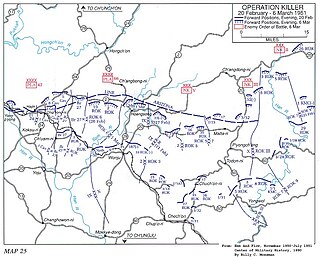
Operation Killer was a military operation that marked the start of the second major counter offensive which United Nations Command (UN) forces launched against the Chinese Communist People's Volunteer Army (PVA) and the North Korean Army (KPA) during the Korean War. The offensive lasted from 20 February to 6 March 1951 and was formulated by General Matthew Ridgway with the goal of annihilating enemy forces south of a line designated the Arizona Line. The operation was immediately followed by Operation Ripper.
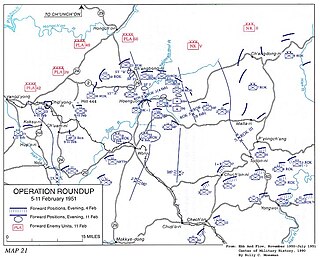
Operation Roundup was an advance by United Nations Command (UN) forces during the Korean War that took place from 5 to 11 February 1951. While achieving initial success against limited opposition, it was brought to a halt by Chinese People's Volunteer Army (PVA) and North Korean Korean People's Army (KPA) forces at the Battle of Hoengsong.
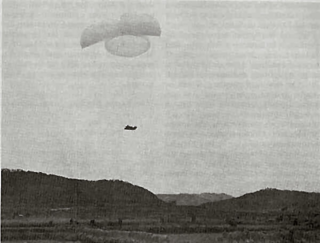
The Battle of Yongyu, also known as the Battle of the Apple Orchard or the Battle of Yongju by the Australians who fought in it, took place between 21 and 22 October 1950 during the United Nations Command (UNC) offensive into North Korea against the Korean People's Army (KPA) that had invaded South Korea during the Korean War. The battle was fought between the 3rd Battalion, Royal Australian Regiment of the 27th British Commonwealth Brigade and the KPA 239th Regiment.
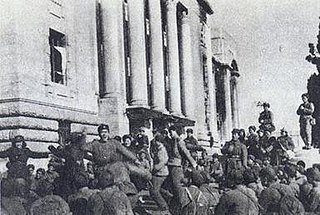
The Third Battle of Seoul was a battle of the Korean War, which took place from December 31, 1950, to January 7, 1951, around the South Korean capital of Seoul. It is also known as the Chinese New Year's Offensive, the January–Fourth Retreat or the Third Phase Campaign Western Sector.

The First and Second Battles of Wonju, also known as the Wonju Campaign or the Third Phase Campaign Eastern Sector, was a series of engagements between North Korean and United Nations (UN) forces during the Korean War. The battle took place from December 31, 1950, to January 20, 1951, around the South Korean town of Wonju. In coordination with the Chinese capture of Seoul on the western front, the North Korean Korean People's Army (KPA) attempted to capture Wonju in an effort to destabilize the UN defenses along the central and the eastern fronts.
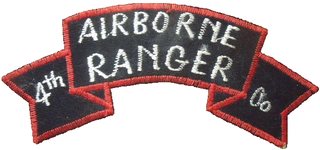
The 4th Ranger Infantry Company (Airborne) was an airborne-trained infantry unit that was part of the United States Army during the Korean War. The 4th Rangers were created as a result of the actions of North Korean Special Forces units such as the KPA's 766th Independent Infantry Regiment that were overrunning Republic of Korea Army (ROK) and United Nations (UN) units. North Korean special units that were trained in the art of unconventional warfare were beating the ROK and UN units that were stationed in South Korea, pushing them back towards the Pusan Perimeter.

The Chinese spring offensive, also known as the Chinese Fifth Phase Offensive, was a military operation conducted by the Chinese People's Volunteer Army (PVA) during the Korean War. Mobilizing three field armies totaling 700,000 men for the operation, the Chinese command conducted their largest offensive operation since their Second Phase Offensive in November and December 1950. The operation took place in the summer of 1951 and aimed at permanently driving the United Nations Command (UN) forces off the Korean peninsula.

Operation Dauntless was a military operation performed by the United Nations Command (UN) during the Korean War designed to advance the UN lines to positions 10–20 miles (16–32 km) north of the 38th Parallel designated the Wyoming Line which would threaten the Chinese and North Korean logistics hub marked out by the towns of Pyonggang, Ch'orwon and Gimhwa-eup named the Iron Triangle. The operation immediately succeeded Operation Rugged which took the UN forces to the Kansas Line 2 to 6 miles north of the 38th Parallel. The operation was initially successful, reaching its initial objectives, but was brought to a halt by the Chinese Spring Offensive on 22 April 1951.

The Battle of the Soyang River, also referred to as the "May Massacre", or Battle of Hyeon-ri in Korean and Chinese was fought during the Korean War between United Nations Command (UN) and the Chinese People's Volunteer Army (PVA) and Korean People's Army (KPA) during the Spring Offensive of April–May 1951. The attack took place across the entire front but with the main thrust below the Soyang River in the Taebaek Mountains. The objective of the main effort was to sever the six Republic of Korea Army (ROK) divisions on the eastern front from the remainder of the US Eighth Army and annihilate them and the US 2nd Infantry Division. Secondary attacks would be mounted by PVA and KPA forces across the entire front.

The UN May–June 1951 counteroffensive was a military operation performed by the United Nations Command (UN) during the Korean War launched in response to the Chinese spring offensive of April-May 1951. It was the final large-scale offensive of the war that saw significant territorial changes.

The Third Battle of Wonju, was a series of engagements between North Korean and United Nations (UN) forces during the Korean War. The battle took place from 13 to 18 February 1951 north of the South Korean town of Wonju.
The UN offensive into North Korea was a large-scale offensive in late 1950 by United Nations (UN) forces against North Korean forces during the Korean War.
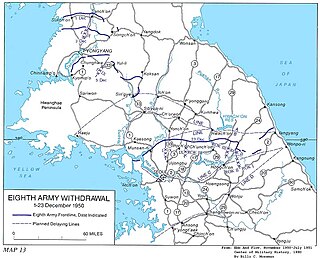
The UN Forces retreat from North Korea was the withdrawal of United Nations (UN) forces from North Korea that took place from 2–25 December 1950.



















